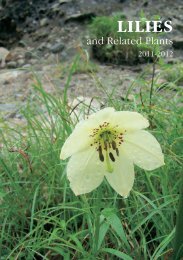LILIES - RHS Lily Group
LILIES - RHS Lily Group
LILIES - RHS Lily Group
Create successful ePaper yourself
Turn your PDF publications into a flip-book with our unique Google optimized e-Paper software.
material is relatively uniform and matches<br />
L. albanicum, which is also found in<br />
Albania, Macedonia and Kosovo. Closely<br />
related taxa, often treated as subspecies<br />
of L. carniolicum, occur elsewhere in<br />
the Balkan Peninsula. L. carniolicum<br />
subsp. jankae has recently been reported<br />
from Mt Voras (Kajmakč alan), but a photo<br />
accompanying the report (in the Greek<br />
journal Fisis 109: 20, 2005) clearly shows<br />
a rich-flowered form of L. albanicum. The<br />
latter had in fact been collected on Mt<br />
Voras (probably just north of the present<br />
border) already in 1893 by the Austrian<br />
botanist Ignatz Dörfler. Lilium jankae<br />
(L. carniolicum subsp. jankae) is a more<br />
robust plant with larger and somewhat paler<br />
flowers, occurring, e.g., on Mount Vitosha<br />
near Sofia. Plants from the Greek side of<br />
Mt Belles (the two dots in the north-eastern<br />
Lilium albanicum on Mt Gramos,<br />
alpine grassland over schist near the<br />
war memorial above Aetomilitsa,<br />
28 June, 2004.<br />
part of the map see pp. 25) are somewhat intermediate between L. albanicum and<br />
L. jankae, but closer to the former.<br />
Characteristic features of L. albanicum are the relatively small size (25-40 cm<br />
tall), 2-4 or occasionally up to 9 deep yellow flowers only 3-4 cm wide, with<br />
distinctly recoiled, deep yellow, unspotted tepals. It grows in damp meadows<br />
on non-calcareous substrates (serpentine, schist or granite) at high altitudes,<br />
generally 1600-2100 m, and flowers relatively early, from mid-June to mid-July.<br />
In cultivation in southern Scandinavia it flowers in the end of May and beginning<br />
of June. It is relatively easy to establish but seems difficult to keep for any length<br />
of time, being susceptible to diseases.<br />
2. Lilium candidum<br />
The well known white lily or Madonna <strong>Lily</strong> has been cultivated in the eastern<br />
Mediterranean area since antiquity. In Christianity it became a symbol of purity<br />
associated with the Virgin Mary, it was widely grown in monasteries and is a<br />
common motif in religious art. In addition to its ornamental and symbolic value<br />
it had reputed cosmetic and medicinal properties. From Britain it is mentioned<br />
as early as the seventh century A.D., and it features in the plays of Shakespeare,<br />
apparently being a well known plant at that time. It is hardy as far north as<br />
southern Scandinavia.<br />
21




